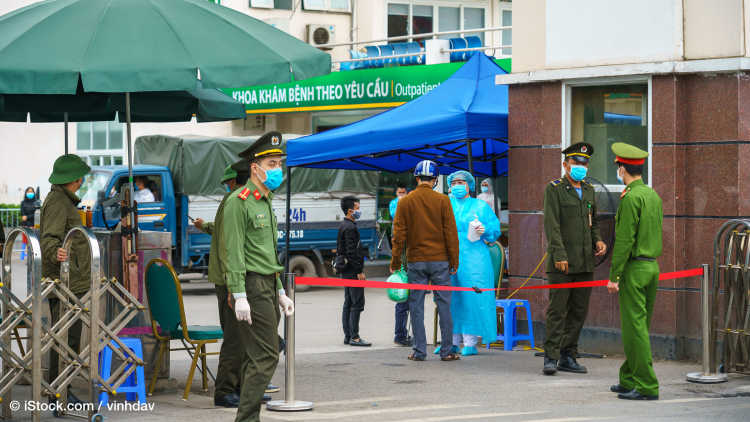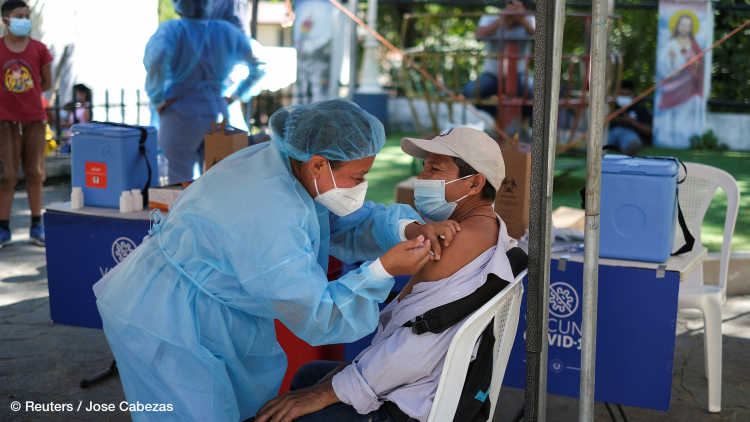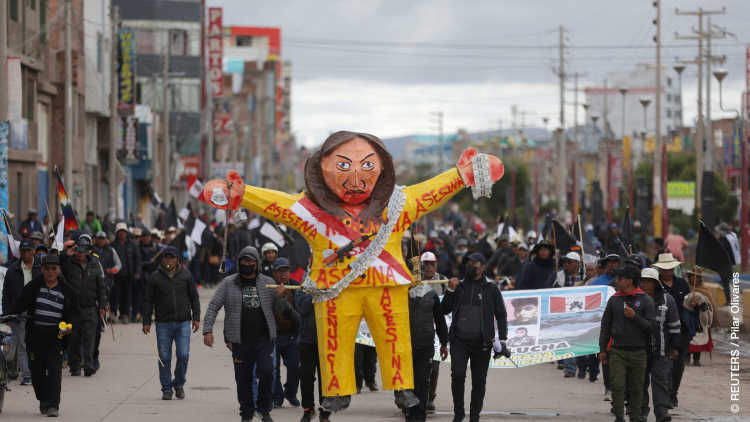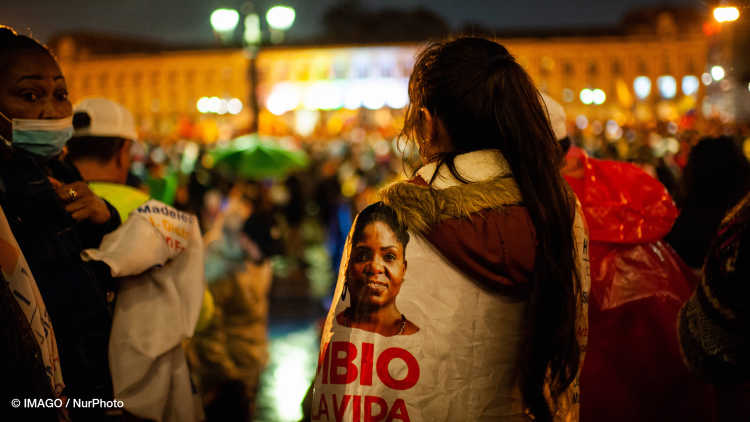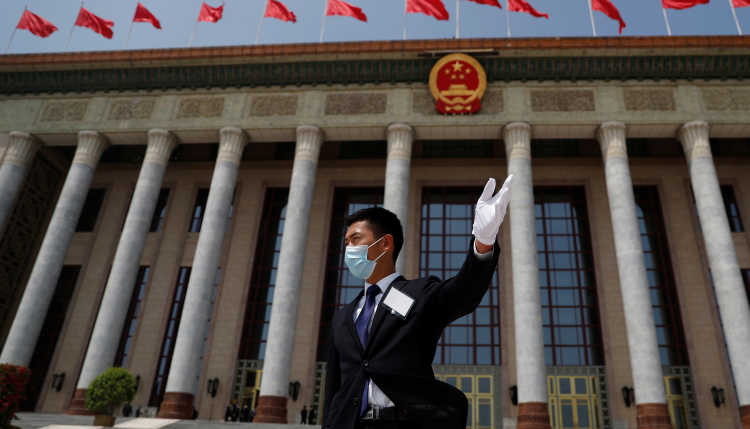- Home
- Publications
- GIGA Focus
- The Shadow Pandemic: Policy Efforts on Gender-Based Violence during COVID-19 in the Global South
GIGA Focus Global
The Shadow Pandemic: Policy Efforts on Gender-Based Violence during COVID-19 in the Global South
Number 6 | 2021 | ISSN: 1862-3581

Even before COVID-19 hit, one in three women experienced violence by a partner or sexual violence by a non-partner, according to the World Health Organization. With the pandemic, the risk of violence against women and children, especially within the home, increased further as people sheltered at home while facing great financial and emotional stress. Our assessment of government policies in a cross-regional sample of countries in Latin America, the Middle East, and Africa since the pandemic’s onset in early 2020 finds that
governments increased communication and digital services addressing GBV, such as hotlines, counselling, and reporting mechanisms, but struggled to meet increased demand for emergency services;
states with existing robust GBV services were better prepared to continue service provision during the pandemic; beyond this, the gender ideology of the political leader made a difference in prioritisation and visibility;
in Latin America, national-level responses were heterogeneous, ranging from dismissiveness by the presidents of Mexico and Brazil to new and proactive policies by the government of Argentina; and
in neither Uganda nor any of the countries studied in MENA were shelters classified as essential services. Even in South Africa, where shelters were classified as essential, lockdowns complicated access.
Policy Implications
There is an urgent need for stronger policy responses to GBV, and not just for humanitarian reasons. The United Nations has estimated the economic costs of violence against women at about 2 per cent of global GDP. Governments need to ensure that emergency GBV services exist beyond hotlines and remain open and accessible around the clock. Non-governmental organisations play a vital role in GBV service provision but should not substitute for government provision. German and EU policies should encourage and support the development of GBV infrastructure, including first-response services, shelters, and gender-sensitive social protection programmes.
Policy Efforts on Gender-Based Violence during COVID-19 in the Global South
Over the past two decades, women’s movements around the world have succeeded in making visible – and politicising – the endemic problem of violence against women. Yet, the reality remains sobering. Even before COVID-19 hit, one in three women experienced violence by a partner or sexual violence by a non-partner, according to the World Health Organization.
When COVID-19 hit, the risk of gender-based violence (GBV), especially within the home, increased further. People were instructed to stay at home during a time where households were facing great financial and emotional stress. Indeed, one year into the pandemic, a systematic review found that the overwhelming majority (between 70 and 80 per cent) of studies showed an increase in violence against women (VAW) and children since March 2020 (Bourgault, Peterman, and O’Donnell 2021).
On the basis of policy reviews in eight Latin American countries, three countries in the Middle East, and two in sub-Saharan Africa, we assess government efforts to address and treat gender-based violence since the pandemic’s onset in early 2020. We use the UNDP/UN Women (2020/21) gender tracker as a point of departure, and dive more in-depth with regard to a set of countries. We focus specifically on domestic and intimate partner violence, given the particular risks that sheltering at home have caused over the past year and a half. We do not explicitly include policies addressing violence against children; some but not all overlap with GBV policies. This topic deserves its own systematic review (in the near future).
The countries span different cultural contexts, social norms, and religious institutions, in addition to varying in their reported prevalence of GBV. Yet, across these countries, the policy tools for providing emergency services to those experiencing, or at risk of experiencing, violence in the home were similar: outreach campaigns and hotlines; violence-related first-response health, legal, and social services for survivors; and shelters. These are key services that those at risk need in order to protect themselves and other household members in the short and medium term. In the medium and long term, the range of policies needed to tackle domestic and intimate partner violence is much broader, including education campaigns and, fundamentally, promoting gender equality. Additionally, gender-based violence has a scope that goes beyond the household, of course.
As the need for services to address domestic and gender-based violence increased globally, governments faced the challenge of shifting a bulk of them to virtual mediums while maintaining the continuity of essential physical services, such as medical attention, protective services, and shelters. How prepared these governments were when the pandemic hit – and the policy efforts they have made since – varies dramatically from country to country. All countries reviewed here bolstered, or created for the first time, hotlines and online tools to address domestic violence. Across the world, requests for help through hotlines surged; in fact, in places where such requests declined, it was more likely due to lack of accessible hotlines than to lack of need. Indeed, reports of higher numbers of calls should be read, in the short term, as policy success in responding to increased need, while lower numbers of calls are a troubling sign of lack of reach. Below, we discuss the countries by region and conclude with policy recommendations.
Latin America: Brazil, Mexico, Argentina, Uruguay, Chile, Peru, Bolivia, Ecuador
In the past quarter century, Latin American governments have improved their normative commitments to GBV following feminist mobilisation and the landmark 1994 Inter-American Belém do Pará Treaty. They revised legislation, established national action plans, and developed GBV services; by 2017 nearly all countries in the region had laws against domestic violence (Tavares and Wodon 2018: 6). Yet the gap between laws and implementation was a yawning one, and in 2015, after a series of femicides – the latest of which being that of a 14-year-old girl named Chiara Páez, who was murdered by her boyfriend – the “Ni una menos” (“Not one less”) protests exploded in Argentina, and quickly spread throughout the region. These protests culminated in the massive “El violador en tu camino” (“The rapist in your path”) demonstrations in late 2019 and in the 8 March Women’s Day strikes in 2020 that took place just days before the world closed due to the coronavirus pandemic.
In early 2020, the Latin American countries analysed here all had a basic GBV policy infrastructure in place, including dedicated hotlines, centres where survivors could seek legal, medical, and psychological help, and at least some shelters. Access to these services varied widely between (and also within) the countries, depending on state capacity and on efforts to improve GBV infrastructure; the latter was influenced by women’s movements, the strength of women’s policy agencies inside the state and the ideology of the government in office. Federalism posed its own challenges for coordination.
In the days following the declaration of the COVID-19 pandemic, governments in Latin America reacted rapidly by instituting lockdowns or social-distancing measures of varying degrees. They also created online tools and WhatsApp numbers through which individuals could seek help on domestic violence and established or bolstered campaigns to spread awareness of violence in the home. An example that garnered significant media coverage was the “Mask-19” campaign, which started in Spain and spread to Latin America. It involved establishing reporting mechanisms in accessible spaces – pharmacies and supermarkets, given lockdowns – where women could seek help with a code word. However, there is no concrete data on how much these campaigns really helped aside from raising awareness, and there have been reports of staff mishandling situations or not knowing the code word, potentially further endangering those seeking help (Saavedra 2020).
Of our countries of study, all except Bolivia and Ecuador reported increased calls to hotlines in April and May of 2020; in these two countries, the decline was taken by officials as a worrisome sign of people being unable to reach help rather than a decline in need. More widespread were declining numbers of official reports of violence – for example, in Chile, Mexico, and Argentina, seemingly indicative of decline in access to police and legal services. Most troubling may be declines in official reports of child maltreatment – for example, in Mexico and Brazil, as school closures and other measures left children isolated.
Governments also struggled to maintain essential face-to-face services. Coherent policy responses were supported or undermined by leaders, ranging from deprioritisation and dismissal of concerns by the presidents of Brazil and Mexico to proactive policies by the government of Argentina. The respective presidents of Uruguay, Chile, Ecuador, Peru, and Bolivia were neither promoters nor dismissive of feminist demands, and in these countries, policy responses were largely driven by the strength of existing state capacity and GBV policy infrastructure.
Brazil had developed a relatively advanced GBV infrastructure during recent left-wing governments, including women’s centres, women’s police stations, and shelters. However, following the impeachment of President Dilma Rousseff in 2016, the government of conservative Michel Temer, and especially that of far-right Jair Bolsonaro since 2019, rolled back federal-level advances, as Prange de Oliveira (2021) recounts in her working paper, from which we draw here.
One of President Temer’s first actions was to subsume the Women’s Ministry into the Ministry of Justice, thereby decreasing its autonomy. This was followed by a steep decline in the federal budget for projects combatting VAW, which was cut by more than half from 2016 to 2017. The decline continued under Bolsonaro, who told feminists they should stop “whining” about femicide. He folded the women’s policy agency into a new Ministry of Women, Family and Human Rights, and undermined its autonomy further (Prange de Oliveira 2021).
At the start of the pandemic, concerned officials in the government mobilised. The new Ministry of Women, Family and Human Rights developed virtual services for those confined at home with potential aggressors. Officials in the Ministry of Health issued a technical note establishing that sexual and reproductive health services should be classified as essential. However, the Bolsonaro government refused to do so and instead let the officials responsible for the note go. While the government initially allocated additional resources for GBV, only a small share of the resources had been spent by the year’s end.
The government’s inaction prompted advocates to seek out other channels. Feminist legislators in Congress submitted a bill to classify domestic violence services as essential, which was approved in July 2020. A year into the pandemic (March 2021), the municipal government of São Paulo passed a law that grants survivors of domestic violence in situations of extreme vulnerability cash transfers to enable them to rent safe spaces.
As in Brazil, the Mexican president has been openly dismissive of gender-based and domestic violence. Mexico, however, despite its advances in addressing VAW, had a weaker national-level GBV policy infrastructure than Brazil to begin with: it had no national-level GBV hotline when the pandemic hit, though the general 911 hotline had a special protocol to process reports of violence against women, and five states had their own helplines. The national government-maintained women’s centres and about half of the shelters in the country were publicly run, the other half being privately run with subsidies.
Since assuming power, President Andrés Manuel López Obrador (known as AMLO) has implemented an austerity agenda, resulting in cuts to GBV services, particularly shelters and centres for indigenous women (EQUIS, RNR, and INTR 2020). The president has a highly conflictual relationship with feminist organisations. In early 2020, sparked by the brutal murders of 25-year-old Ingrid Escamilla, who was skinned and dismembered, and 7-year-old Fátima Antón, whose body was found in a plastic bag shortly after she went missing, women’s organisations held massive protests. Following a demonstration on International Women’s Day on 8 March 2020, AMLO criticised it as an opportunity for conservatives “masquerading as feminists” to protest his government, reiterating the claim a year later.
The Mexican national government did declare GBV services essential during the pandemic. However, the budget cuts combined with increased demand for services overwhelmed both public and civil society organisations. Most stunningly, during the first months of the pandemic, when calls related to domestic violence spiked on the 911 hotline, AMLO claimed that “90 per cent” of these calls were “false” (EQUIS, RNR, and INTR 2020: 18).
Argentina, as a federal country, faces challenges similar to those of Brazil and Mexico. That said, its recent trajectory contrasts with the other two. Until 2015, the women’s policy agency was quite low in the hierarchy, playing a mainly symbolic role (Rodríguez Gustá 2021). Centre-right president Mauricio Macri (2015–2019) elevated its position and increased the budget, in the context of massive mobilisation by an active feminist movement from which the “Ni una menos” demonstrations emerged. In December 2019, after campaigning with an explicitly feminist agenda, newly elected left-wing president Alberto Fernández created the Ministry of Women, Genders and Diversity and appointed feminists to key ministries and government positions.
The government had just begun establishing its gender equality agenda when the pandemic started. Along with one of the strictest lockdowns in the region, the government bolstered its GBV first-response systems, exempted victims of GBV from mobility restrictions, and streamlined complaints of domestic violence. The government faced a fragmented federal system on GBV policies. First-response systems are run by different levels of government and by different agencies, with some shelters coming under the purview of NGOs (Sohr and Slipczuk 2020). To foster coordination, the federal government created new institutional spaces. One innovative initiative is the Acompañar programme, announced in September 2020. The programme provides a six-month cash transfer at minimum wage to survivors of GBV, to help them gain economic autonomy. The stated coverage goal for 2021 was 92,000 people; by September, 54,000 had been reached, which had involved setting up hundreds of local units across the country.
Both Uruguay and Chile have more developed social infrastructure in the context of the region and had invested in domestic violence services under recent programmatic leftist governments. Uruguay has a low-level hierarchy women’s policy agency but an active National Advisory Council that contributes to the state strategy for the eradication of gender-based violence. The Uruguayan government maintained women’s centres and shelters, along with a housing programme for survivors. A practical policy in place since 2013 entailed aggressors wear electronic anklets to prevent them from approaching the victims. These anklets had been 100 per cent effective in keeping aggressors away from victims until one femicide attempt in March 2021 (Pieper, Blofield, and Madera 2021). The government-provided GBV hotline, however, was not operational 24 hours a day; at night, callers had to rely on the general 911 helpline.
Just when the pandemic hit the region, in March 2020, a new, conservative government assumed office. Uruguay, with the lowest labour informality in the region and a well-developed social infrastructure, was better positioned to implement containment policies. The government relied on voluntary social-distancing restrictions, and face-to-face services for survivors of violence largely continued to operate normally. For example, while hotline calls increased more than threefold, face-to-face consultations decreased only minimally. The government did not, however, proactively bolster VAW services to meet increased need, despite pressure from women’s organisations. Only in July 2021 did the government make the GBV hotline 24/7, in response to continued pressure.
The Chilean government, through its strong Ministry of Women and Gender Equity (previously the National Women’s Service), had established a 24/7 hotline, women’s centres, and shelters prior to the pandemic. Additionally, during the feminist-left government of Michelle Bachelet (2014–2018), the country had established so-called Men’s Re-Education Centres to rehabilitate aggressors. The right-wing government of Sebastián Piñera (2018–present) had been the target of the country’s explosive social protests starting in October 2019, and in November, the so-called “feminist hymn” of the four-person Chilean ensemble Las Tesis “El violador en tu camino” exploded worldwide.
When the pandemic hit, the government reacted rapidly to meet increased demand for domestic violence services. However, as the calls surged, the capacities of women’s centres were not bolstered, and even emergency cases did not receive sufficient follow-up (Rein Venegas et al. 2021). Opposition women legislators called for more funding. For 2021, the government increased the budget for VAW services by 36 per cent, and established training initiatives for the police (Pieper, Blofield, and Madera 2021).
In Peru, Ecuador, and Bolivia, governments had lower state capacity and high political instability, with all three struggling to maintain essential face-to-face services as the pandemic hit hard. Despite overall weak social protections, Peru had, with a strong women’s policy agency, an infrastructure of nearly 400 women’s emergency centres. However, when the pandemic hit, during Peru’s strict initial lockdown, GBV policy was uncoordinated: hotline staff instructed callers with emergencies to go to these centres; however, they were closed during the lockdown. Mobile services were eventually set up but reached fewer people.
Bolivia struggled with fragmented institutions. While it had a variety of GBV first-response services, these struggled with basic capacity such as internet coverage in their offices. When the pandemic hit, the government did not expressly declare these services as essential. Moreover, even though the GBV hotline was supposed to be toll-free, in many places it was not, constituting a barrier in South America’s poorest country, one with 80 per cent labour informality. Initially, the hotline registered a decrease in calls, prompting the government to establish WhatsApp lines to reach people better.
Ecuador had a relatively well-developed GBV policy infrastructure; however, the government had slashed the GBV budget by 84 per cent between 2019 and 2020, leading to cuts in staff for essential services. Moreover, the only 24/7 GBV hotline was the 911 hotline for general emergencies (although with specialised staff). With the lockdown, the government bolstered the emergency helpline. Yet domestic violence calls decreased, as the lines were flooded by COVID-19 emergencies. Moreover, a government report indicates that only 10 per cent of the domestic violence calls were attended (Pieper, Blofield, and Madera 2021).
Sub-Saharan Africa: South Africa and Uganda
Sub-Saharan Africa as a region is characterised by lower state capacity; moreover, about half of the countries do not have laws against domestic violence (Tavares and Wodon 2018: 6). Here we examine two countries – Uganda and South Africa – that do have legal commitments against domestic and gender-based violence but face challenges regarding implementation.
South Africa has undergone significant legal reforms on violence against women, including domestic violence. Yet implementation of these laws remains a challenge, as Mohamed (2021) shows in her working paper on that country, from which we draw here. Prior to COVID-19, the government maintained toll-free GBV helplines, Victim Empowerment Centres in police stations for GBV survivors, and at least 98 shelters for women and children affected by gender-based violence (provided by both government and civil society). Despite legal guarantees, however, demand far outweighed supply of shelters and transitional housing. At the Victim Empowerment Centres, many women report being further violated by the police themselves (Mohamed 2021). After brutal attacks against women and ensuing massive protests by women in 2019, the government presented an emergency plan to address VAW, in September 2019, and allocated funding for the plan, to be implemented in 2020.
When the COVID-19 pandemic hit South Africa, the president promised to continue with the plan. With the declaration of a state of disaster on 15 March 2020, the government bolstered hotline services, including establishing a legal/justice hotline. The Steering Committee on Gender-Based Violence and Femicide, in consultation with civil society, developed guidelines on GBV (Guidelines for Women on Family Laws n.d.), including ensuring access to helplines; providing public transportation to police stations, shelters, and medical help; broadening access to justice; strengthening infrastructure; and creating more economic opportunities for women. The government also passed a legal reform expanding the definition of domestic violence to broader relationships and allowing victims to apply online for a protection order. However, difficulties in smartphone access, the high cost of data, and irregular or poor access to the internet, combined with unpredictable power outages, reduced access in practice.
The president directed the police to ensure that units dedicated to family violence, child protection, and sexual offences were reinforced during the lockdown and beyond. Shelters were also classified as an essential service. However, this did not translate into adequate funding increases; the shelters, as well as the NGOs providing practical support, were overwhelmed by the increased demand. In February 2021, the South African government established a national council on GBV and increased funding to programmes fighting GBV.
A further challenge in South Africa has been the provision of healthcare services. For one example, even while the number of GBV cases reported to police markedly increased with the lockdown, Doctors Without Borders reported a sharp decrease in visits to their victim care centres, focused on survivors of violence, citing lockdown-related barriers.
Uganda’s legal framework is supportive of gender equality, and internationally, it is applauded for its GBV policies. However, as Kampire (2021) shows in her working paper, from which we draw here, implementation falls short, and many practices are still in direct conflict with the progressive legal framework. Also, a key challenge is the limited knowledge of these laws – which are mostly only available in English – among key stakeholders, most of whom do not speak English.
In terms of first-response services, the legal system includes both formal and informal local justice. The former is hard to access, given geographical distance, expense, and time-consuming administrative processes. The informal justice system, on the other hand, is perceived as focused on maintaining the status quo rather than promoting the safety of women. There are no government-run women’s centres: the country’s 19 shelters are all run by civil society organisations with international funding. The Ministry of Gender, Labour and Social Development (MGLSD), with international funding, maintains a free helpline on violence against children.
When the pandemic started, the president did not declare the GBV-related first-response systems essential, and the organisations were affected by the strict lockdown. Moreover, public transportation was shut down, making shelters inaccessible for most. Legal services halted initially and only later began to move online. During the lockdown, the MGLSD designed an online app called SafePal to enable survivors of GBV to report cases. However, many Ugandans cannot afford smartphones and data. Indeed, reports of GBV-related cases declined between March and June 2020. The toll-free 24/7 helpline for children did continue to function, also receiving some cases of violence against women, and civil society organisations set up further toll-free helplines. While the police were busy enforcing COVID measures, they also, with support from UN Women, established a toll-free hotline for reporting violence against women and girls.
In August 2020, the international funding that had sustained most of the GBV shelters in Uganda ended. Fundraising for temporary donations has helped keep most of the shelters open into 2021. Efforts are being made to raise more funds as demand for the services keeps rising, a need also recognised by the MGLSD. Despite the increased hardship, the ministry had its budget cut by 15 per cent between 2019–2020 and 2020–2021 (Kampire 2021).
Middle East and North Africa: Egypt, Lebanon, and Turkey
The Middle East and North Africa, as a region, is characterised by higher state capacity than sub-Saharan Africa. However, as of 2017, almost two-thirds of the countries in the region lacked laws against domestic violence (Tavares and Wodon 2018: 6). Here, we focus on Egypt, Lebanon, and Turkey, which have all made legal advancements over the past two decades, ranging from recognising violence against women and prohibiting female genital mutilation to reforming the Constitution to reflect equal rights, in the case of Egypt (National Council for Women 2014); this progress is largely due to efforts by women’s movements. However, over the past few years leaders in all three countries have sidelined the issue of violence against women.
Compared to Latin America especially, these countries are also characterised by much less policy infrastructure dedicated to addressing GBV in terms of government-provided hotlines, women’s centres, and shelters. While in Egypt and Turkey there have been many legal changes since the early 2000s, few steps have been taken in terms of implementation. Lebanon struggles with issues of basic state capacity due to political conflict. In Egypt and Lebanon, services to address VAW fall largely to civil society organisations, mainly funded by international aid. There are also no coordinating mechanisms between the governments and civil society, which would increase the effectiveness of national projects.
Egypt’s Constitution, enacted in 2014, enshrines equality between women and men (National Council for Women 2014). However, follow-up to constitutional rights is lacking, although some steps have been taken, such as efforts to eliminate female genital mutilation. Egypt, with a population of over 100 million, has just nine shelters, operated by the Ministry of Social Solidarity and civil society organisations. Services such as hotlines and psychological support have all been delivered by civil society organisations that operate under restricted conditions.
When the pandemic hit, the government set up, for the first time, a hotline to respond to women survivors of violence. Additionally, the National Secretariat of Mental Health established a hotline to provide psychological support to people due to COVID-19. Other existing helplines and reporting mechanisms extended working hours (UNDP/UN Women 2020/21). The government also took measures to keep courts and shelters working during the pandemic. In July 2020, the Egyptian parliament passed a bill to ensure “full confidentiality” to GBV survivors reporting crimes, in order to “protect their reputation” (National Council for Women 2020).
In Lebanon, a pluralistic religious legal system presents a particular challenge regarding women’s rights and domestic violence, as citizens are treated differently based on the religious community/sect to which they belong, and the institutions that regulate family law are patriarchal. Women have very inadequate access to GBV-related healthcare services, and shelters and hotline services are delivered by civil society organisations.
Following a surge of reports of domestic violence with the pandemic, the National Commission for Lebanese Women, in cooperation with the government, set up a domestic violence hotline for the first time (UNDP/UN Women 2020/21). Overall, Lebanon faced tremendous challenges during 2020; the Beirut blast in August 2020 drove the country further into a humanitarian and political crisis.
Shelters in Lebanon have remained mostly functioning during the pandemic but are few and far between. Legal complaints of domestic violence face a court system that is overwhelmed and unprepared to handle such cases (UN Women 2020). Women’s inability to access healthcare services in relation to GBV is compounded by a weak healthcare system overall.
In Turkey, the Istanbul Convention (Council of Europe Convention on preventing and combating violence against women and domestic violence) of 2011 provided an impetus to policy efforts addressing GBV in the country. Today, GBV policy infrastructure is provided by the government and domestic civil society organizations. However, since President Erdoğan assumed power in 2014, he has taken positions more concerned with “family integrity” than with women’s rights, and civil society organisations not aligned with the government face restrictions. Even when not enshrined in law, the president’s conservative views, bolstered by his conservative majority in Congress, have influenced policy. For example, a congressional commission in 2016 produced a report that favoured mediation over shelter for abused women and urged more involvement by the Religious Affairs Directorate in family counselling. This directorate urges women to remain married even when subjected to violence.
When the pandemic hit, existing hotlines, crisis centres, and shelters remained operational, although they were not classified as essential. Civil society organisations, however, report that the shelters, for example, turn back some women, such as sex workers and women over 60. Moreover, prosecutors have been instructed since March 2020 to consider health risks to perpetrators in issuing protection orders, thus allowing for them to remain in the home with the victim.
In March 2021, in a dismaying move, the Turkish government withdrew from the Istanbul Convention, claiming that it has been distorted to “normalise homosexuality” and is incompatible with Turkish family values. This, and other acts by the Erdogan government, have sparked persistent protests by women’s rights activists.
Looking to the Future: The Need to Invest in GBV Policy Infrastructure
Despite diverse cultural and political contexts, the challenges faced by those at risk of violence in their homes during the past year and a half of lockdowns and associated hardships have been similar: being able to contact emergency services for help, and if necessary, to access medical, legal, and social assistance and to shelter in a safe space and establish living conditions without violence. How well states have been able to meet these needs varies, influenced by their policy infrastructure at the time the pandemic hit and by their efforts since then. Equitable legal frameworks are, of course, necessary to build a policy infrastructure supportive of addressing domestic and gender-based violence. Beyond this, it takes prioritising the issue and allocating stable budget commitments to policies and services.
Over the past year and a half, many governments made significant efforts to reach out to people at risk of domestic and gender-based violence, through communication campaigns and hotlines. In this process, they have likely raised awareness of the problem and established avenues of communication to more people than before. And, while lip service may be cheap, it is certainly better than actively dismissing the problem, as some have done.
However, these efforts must be combined with sustained resources over the medium and long term to ensure stable and accessible emergency services. In particular, governments need to ensure that first-response GBV services exist beyond hotlines and remain accessible around the clock, so if one calls in an emergency, one has somewhere to go. These centres should bundle legal, health, and social services in “one-stop shops” with a gender and intersectional perspective on violence, have broad geographical coverage, and ensure public transportation to them.
In the medium term, governments should reinforce national coordination mechanisms and empower women’s policy agencies that advocate for GBV treatment and prevention. While NGOs play a vital role in GBV service provision, they should not substitute for government provision, and services should be coordinated between the two to ensure efficient provision and equitable access. Governments should also ensure stable, non-discretionary budget commitments to enable investments in further infrastructure for emergency services and shelters, along with investing in policies to allow survivors to move on with their lives securely, including housing and gender-sensitive social protection programmes. German and EU policies should encourage and support the development of GBV infrastructure, including first-response services, shelters, and gender-sensitive social protection programmes.
Footnotes
References
Bourgault, S., A. Peterman, and M. O’Donnell (2021), Violence against Women and Children during COVID-19—One Year On and 100 Papers In. A Fourth Research Round Up, Center For Global Development, www.cgdev.org/publication/violence-against-women-and-children-during-covid-19-one-year-and-100-papersfourth (11 October 2021).
EQUIS, Justicia para Mujeres; RNR, Red Nacional de Refugios; Intersecta (2020), Informe Elaborado Para La Relatora Especial de Naciones Unidas Sobre La Violencia Contra La Mujer, Sus Causas y Consecuencias, https://equis.org.mx/wpcontent/uploads/2020/08/informe-dospandemiasmexico.pdf (11 October 2021).
Guidelines for Women on Family Laws. Lebanon (n.d.), ىفك ., https://kafa.org.lb/en/node/164 (8 October 2021).
Kampire, Pamela (2021), The Impact of the COVID-19 Pandemic on Gender-Based Violence Uganda: A Policy Review and Analysis, GIGA COVID-19 Gender-Based Violence Policy Tracker Working Paper #2 (October), German Institute for Global and Area Studies (GIGA), www.giga-hamburg.de/de/projekte/policy-trackergender-based-violence/ (18 October 2021).
Mohamed, Zaheda (2021), South Africa: Policy Effort on Violence against Women and Children/Domestic Violence before and since COVID-19, GIGA COVID-19 Gender-Based Violence Policy Tracker Working Paper #3 (October), German Institute for Global and Area Studies (GIGA), www.giga-hamburg.de/de/projekte/policy-tracker-gender-based-violence/ (18 October 2021).
National Council for Women (NCW) (2020), Notable NCW Accomplishments 2020. Egypt, http://ncw.gov.eg/ (11 October 2021).
National Council for Women (NCW) (2014), National Report (Issue c). Egypt, http://ncw.gov.eg/ (11 October 2021).
Pieper, Johanna, Merike Blofield, and Nancy Madera (2021), Domestic Violence Infrastructure before and since COVID-19 in Uruguay, Chile, Peru, Bolivia and Ecuador, GIGA COVID-19 Gender-Based Violence Policy Tracker Working Paper #4 (October), German Institute for Global and Area Studies (GIGA), www.giga-hamburg.de/de/projekte/policy-tracker-gender-based-violence/ (18 October 2021).
Prange de Oliveira, Stefanie (2021), Brazil: Policy Effort on Violence against Women and Children/Domestic Violence before and since COVID-19, GIGA COVID-19 Gender-Based Violence Policy Tracker Working Paper #1 (September), German Institute for Global and Area Studies (GIGA), www.giga-hamburg.de/de/projekte/policy-tracker-gender-based-violence/ (18 October 2021).
Rein Venegas, Tatiana, Fernanda Raquel Page Poma, María José Elizalde Roa, and Natalia Sabrina Magnetico (2021), Medidas Estatales Para Prevenir La Violencia Contra Las Mujeres En Tiempos de COVID-19. Informe de Investigación, Santiago de Chile: Universidad de Chile, www.iei.uchile.cl/publicaciones/178674/medidas-estatales-para-prevenir-la-violencia-contra-las-mujeres (11 October 2021).
Rodríguez Gustá, Ana Laura (2021), Women’s Policy Agencies and Government Ideology: The Divergent Trajectories of Argentina and Brazil, 2003–2019, in: International Feminist Journal of Politics, 23, 4, 625–647.
Saavedra, Monserrat (2020), Mucho ruido, pocas nueces: las brechas en las medidas chilenas. Violentadas en Cuarentena, published 11/11/2020, https://violentadasencuarentena.distintaslatitudes.net/portfolio/chile/ (7 October 2021).
Sohr, Olivia, and Martín Slipczuk (2020), Violencia de género: ¿qué pasó con los refugios para las mujeres que son víctimas?, Argentina: Chequeado, https://chequeado.coReiunm/el-explicador/que-paso-con-los-refugios-para-las-mujeres-victimas-de-violencia-de-genero/ (11 October 2021).
Tavares, Paula, and Quentin Wodon (2018), Global and Regional Trends in Women’s Legal Protection against Domestic Violence and Sexual Harassment, World Bank, https://thedocs.worldbank.org/en/doc/140781519943384134-0050022018/original/EndingViolenceAgainstWomenandGirlsGBVLawsFeb2018.pdf (11 October 2021).
UNDP/UN Women (2020/21), COVID-19 Global Gender Response Tracker, https://data.undp.org/gendertracker/ (1 January to 31 December 2020; 8 October 2021).
UN Women (2016), The Economic Costs of Violence against Women, www.unwomen.org/news/stories/2016/9/speech-by-lakshmi-puri-on-economic-costsof- violence-against-women (11 October 2021).
UN Women (2020), Women’s Needs and Gender Equality in Lebanon’s Covid-19 Response, https://arabstates.unwomen.org/en/digital-library/publications/2020/03/gender-equality-in-lebanon-covid-19-response (11 October 2021).
General Editor GIGA Focus
Editor GIGA Focus Global
Editorial Department GIGA Focus Global
Research Programmes
How to cite this article
Blofield, Merike, Asma Khalifa, Nancy Madera, and Johanna Pieper (2021), The Shadow Pandemic: Policy Efforts on Gender-Based Violence during COVID-19 in the Global South, GIGA Focus Global, 6, Hamburg: German Institute for Global and Area Studies (GIGA), https://nbn-resolving.org/urn:nbn:de:0168-ssoar-75502-7
Imprint
The GIGA Focus is an Open Access publication and can be read on the Internet and downloaded free of charge at www.giga-hamburg.de/en/publications/giga-focus. According to the conditions of the Creative-Commons license Attribution-No Derivative Works 3.0, this publication may be freely duplicated, circulated, and made accessible to the public. The particular conditions include the correct indication of the initial publication as GIGA Focus and no changes in or abbreviation of texts.
The German Institute for Global and Area Studies (GIGA) – Leibniz-Institut für Globale und Regionale Studien in Hamburg publishes the Focus series on Africa, Asia, Latin America, the Middle East and global issues. The GIGA Focus is edited and published by the GIGA. The views and opinions expressed are solely those of the authors and do not necessarily reflect those of the institute. Authors alone are responsible for the content of their articles. GIGA and the authors cannot be held liable for any errors and omissions, or for any consequences arising from the use of the information provided.










